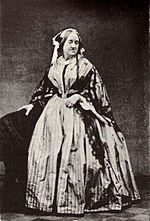Anna Atkins

Anna Atkins (born March 16, 1799 in Tonbridge , Kent , † June 9, 1871 Halstead Place, Halstead , Kent; born Anna Children ) was an English botanist and illustrator . She published the first book that was illustrated exclusively with the help of a photographic process and is considered to be one of the first women photographers .
Live and act
Anna Atkins was the only child of Hester Anne Holwell and John George Children . The mother died several months after she was born. The father, a Fellow of the Royal Society , was a polymath with a variety of scientific interests. Among other things, he dealt with chemistry , mineralogy and zoology . The mineral childrenite and the snake children python ( Antaresia childreni ) were named after him. John Children passed on the fascination for science to the daughter and gave her the freedom to pursue studies and further education. Anna was also interested in artistic techniques, she painted and learned lithography . In 1823 her artistry was so well developed that she was able to create 200 illustrations of shells for the Conchologie von Lamarck , which her father had translated . In 1825 she married the landowner John Pelly Atkins, the marriage remained childless.
Anna and her father met the pioneer of photography William Henry Fox Talbot in February 1839 and were friends with the physicist Sir John Herschel , who had invented the photographic process of the cyanotype in 1839 . Within a year Anna familiarized herself with the new technology in order to be able to produce images of scientific samples as accurately as possible.
Based on the nomenclature of William Henry Harvey's Manual of British Algae from 1841, she published her blueprints in the illustrated book British Algae: Cyanotype Impressions , which for the first time showed images that had been created with the help of a photographic technique. She added twelve more parts to the work from 1843 to 1853. During this time, 389 titled cyanotype photograms with additional text pages were created. A total of twelve copies of the elaborate book were produced, one of which is now in the National Media Museum in Bradford . Atkins made another book with cyanotypes: With the help of her friend Anne Dixon (1799–1864), a cousin of the writer Jane Austen , she collected numerous botanical samples, which she published in 1854 in Cyanotypes of British and Foreign Flowering Plants and Ferns .
Little is known about Anna Atkins' later life. Although their work was of a detailed quality never seen before, it found little acceptance in science and was soon forgotten. In addition, she seemed not to have been interested in marketing her “photographic herbaria ” or it was not possible for her to further publicize her work. In addition, Herschel's cyanotype method received little attention and was quickly replaced by the calotype , which allowed more realistic images. Nevertheless, the cyanotype was the only method that was still used in the following century, for example in a modified form as blueprints ( diazotype ) for architectural drawings . Anna Atkins' cyanotypes were only rediscovered in modern times as an alternative, photographic design method. After her father's death, she wrote a 300-page biography about him in 1853, entitled Memoir of JG Children .
Anna Atkins died at the age of 72. She was buried in Halstead Cemetery.
Works and writings
- 1843/44: British Algae: Cyanotype Impressions
- 1852: The Perils of Fashion
- 1843-1853: British Algae in parts
- 1853: Memoir Of JG Children
- 1854: Cyanotypes of British and Foreign Flowering Plants and Ferns
- 1859: Murder Will Out
- 1863: A Page from the Peerage
literature
- Gerhard Bissell , Atkins, Anna , in: Allgemeines Künstlerlexikon , supplement 1, Saur, Munich 2005, from p. 514.
- Larry J. Schaaf: Sun gardens: Victorian photograms by Anna Atkins . Aperture, New York 1985, ISBN 0-89381-203-X .
- Katharina Steidl: Sea blue prints. Anna Atkins' Cyanotypes as Visual Media and Classification Criticism . In: Photo History , Vol. 40 (2020), Issue 156, pp. 7-18.
Web links
- "Seeing is Believing" - Anna Atkins in the New York Public Library (English)
- Photogrammetric Images in the 1800s - Anna Atkins (English)
- Anna Atkins. In: Photographers. Victoria and Albert Museum , archived from the original on January 20, 2012 ; accessed on March 16, 2015 .
- Anna Atkins, the Cyanotype and Me in the Royal Photographic Society (English)
- Anna Atkins: The Perils of Fashion at google.books (English)
- Anna Atkins at artfacts.net
- Anna Atkins at photography-now.com
- Literature by and about Anna Atkins in the catalog of the German National Library
-
Search for "Anna Atkins" in the online catalog of the Berlin State Library - Prussian Cultural Heritage . Attention : The database has changed; please check result and
SBB=1set
Individual evidence
- ↑ a b “Seeing is Believing” - Anna Atkins. New York Public Library, accessed August 30, 2008 .
- ↑ Obituary - John George Children, Esq .. : The Gentleman's Magazine , Volume 1852, pp. 622-624 (online at ANNO ).
- ↑ a b c Anna Atkins, the Cyanotype and Me ( Memento from November 20, 2008 in the Internet Archive )
- ↑ a b Anna Atkins. Encyclopædia Britannica , accessed August 30, 2008 .
- ^ Boris Friedewald : Anna Atkins . In: Boris Friedewald: Masters of Light: Great Women Photographers from Two Centuries . Prestel, Munich 2014, ISBN 978-3-7913-4673-1 , pp. 16-19
| personal data | |
|---|---|
| SURNAME | Atkins, Anna |
| ALTERNATIVE NAMES | Atkins, Anna Children; Children, Anna (maiden name) |
| SHORT DESCRIPTION | English botanist, illustrator and photography pioneer |
| DATE OF BIRTH | March 16, 1799 |
| PLACE OF BIRTH | Tonbridge , Kent |
| DATE OF DEATH | June 9, 1871 |
| PLACE OF DEATH | Halstead , Kent |


